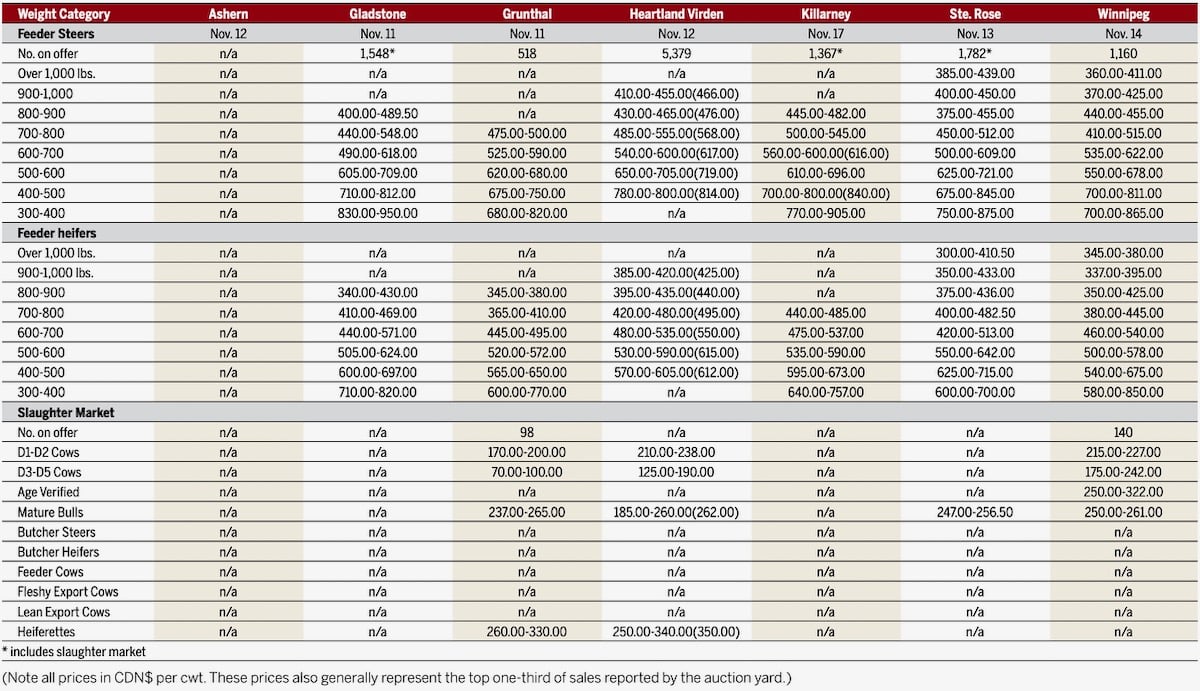The Assiniboine River Basin Initiative (ARBI) becomes a legal, stand-alone entity as of July 1, but where the funding to support it will come from is still in question.
Manitoba has pledged an additional $50,000 beyond an initial $50,000 announced last year to start ARBI, but Saskatchewan and North Dakota have not yet put dollars on the table, said ARBI board chair Allan Preston.
That’s where ARBI’s grassroots supporters need to now step in, he said during an interview at the Prairie Improvement Network annual meeting last week.
Read Also

Manitoba cattle prices, Nov. 17
“Both Saskatchewan and North Dakota are adopting a cautious, wait-and-see attitude and are not moving forward to commit funds as Manitoba has done,” Preston said. “The need that’s becoming more apparent is for these grassroots groups to begin to influence the political side in terms of decision-making.”
Preston is stepping away from his involvement as director with the Prairie Improvement Network (PIN) this spring to devote his efforts toward moving the multi-jurisdictional water management initiative.
ARBI officially formed last November at a meeting in Regina. Many groups, including municipalities and counties, plus farm, conservation and water-management groups pledged support for a cross-boundary planning entity for the Assiniboine Basin.
The Prairie Improvement Network, which has itself been evolving beyond its former role as administrator of federal Canadian Agricultural Adaptation Program (CAAP) since funding ended in 2012, initially proposed the formation of ARBI and committed $360,000 from its own coffers as well as provided staffing support to get it off the ground.
ARBI is a first initiative for PIN in its new role and Preston said it will prove a wise investment.
“We’ve had strong support from the (PIN) board to move forward with this, and we’ve made significant progress,” he said.
Wide-ranging board
The substantial support for ARBI is also evident in the current size of its board.
“We’re sitting at 51 members right now, which is huge,” said Preston.
About 25 met with ARBI’s executive committee in Moosomin, Sask. earlier this month, and have now drafted a mission statement, terms of reference and a work plan and budget to set the entity on its feet this summer.
The executive committee includes Keystone Agricultural Producer president Dan Mazier, Manitoba Conservation District Association chair and reeve of Cornwallis Heather Dalgleish, Patrick Fridgen with the North Dakota State Water Commission and Aron Hershmiller of Saskatchewan Assiniboine Watershed Stewards Association.
Wanda McFadyen is ARBI’s project manager and Lance Yohe, former executive director of the Red River Basin Commission, is its senior adviser and consultant.
Preston said they’ll be working with Brandon University and its Rural Development Institute (RDI) to pursue some potential projects for its graduate students to tackle, which will both generate project-based funding for ARBI as well as give it increasing visibility.
Preston said the expectation most often heard of ARBI is that its main job is to tackle flooding, but that’s only one of many issues it will take on. Drought cycles and water quality are other issues ARBI will want to address, he said.
The basin initiative encompasses an area of about 162,000 sq. km, and takes in the Souris, Qu’Appelle and Assiniboine rivers, for which there are currently eight regional watershed-management plans.
Meanwhile, its parent organization, the Prairie Improvement Network will now look for new initiatives to take forward, said outgoing PIN chair Betty Green. It was always PIN’s intent that ARBI become a separate entity, she said.
“We take these ideas to a certain point and then let them go off on their own so we can explore new opportunities,” she said.
PIN is now seeking feedback on new initiatives to explore, she said.
One idea now eyed is the potential for strategizing towards a more integrated livestock and crop production approach in Manitoba.
“PIN has the capacity to bring organizations together,” Green said. “Sometimes unlikely partners coming to the table can bring enormous benefit and real opportunities can be identified.”
ARBI is a good first example of what’s achievable when that happens, she added.
















